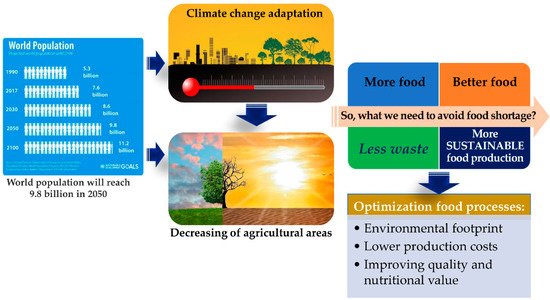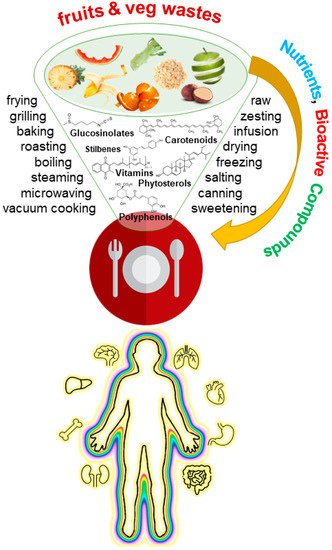Food supply disruption and shortage verified during the current pandemic events are a scenario that many anticipate for the near future. The impact of climate changes on food production, the continuous decrease in arable land, and the exponential growth of the human population are important drivers for this problem. In this context, adding value to food waste is an obvious strategy to mitigate food shortages, but there is a long way to go in this field. Globally, it is estimated that one-third of all food produced is lost. This is certainly due to many different factors, but the lack of awareness of the consumer about the nutritional value of certain foods parts, namely peels and seeds, is certainly among them.
- bioactive compounds
- fruit waste
- vegetable waste
- health
- disease
- peels
- seeds
1. Introduction

2. Nutritional and Bioactive Potential of Fresh Fruit and Vegetable Waste
| Fruit or Vegetable | Edible Part Composition: Nutritional and Bioactive Value | Discarded Part Composition: Nutritional and Bioactive Value | Possible Dietary Uses | Preparation | Ref. |
|---|---|---|---|---|---|
| Fruit | |||||
| Apple | flesh: flavan-3-ols, phenolic acids, flavonols, dihydrochalcones, anthocyanins, and ascorbic acid |
|
|
|
[81,82,83] |
| Banana | flesh: fiber, carbohydrates, phenolics, biogenic amines, phytosterols, minerals; low-fat content |
|
|
|
[8,84,85,86] |
|
|
|
[87] | ||
| Citrus | flesh: carbohydrates, amino acids, polyphenols, flavonoids, vitamin C, minerals |
|
|
|
[86,88,89,90] |
| Grape | flesh: carbohydrates, organic acids, terpenoids, vitamins, minerals, polyphenols |
|
|
|
[91,92,93,94,95,96,97,98] |
|
|
||||
| Kiwi fruit | flesh: dietary fiber, phenolic compounds, vitamins, minerals |
|
|
|
[99,100,101] |
| Mango | flesh: rich in dietary fiber, carbohydrates, proteins, fats, and phenolic compounds |
|
|
|
[86,102,103,104,105,106] |
|
|
||||
| Passion fruit | flesh: vitamin A and C, minerals, dietary fiber, protein, phenolic compounds |
|
|
|
[107,108,109,110,111,112,113,114,115] |
|
|
||||
| Pear | flesh: sugars, vitamins, organic and fatty acids, amino acids, volatiles, polyphenols, minerals |
|
|
|
[116,117] |
| Peach | flesh: dietary fiber, minerals, sugars, organic acids, phenolic compounds, carotenoids, volatiles |
|
|
|
[118,119,120] |
| Pineapple | flesh: carbohydrates, dietary fiber, sugars, organic acids, vitamins, minerals |
|
|
|
[73,121,122,123] |
|
|
|
|||
| Plum | flesh: phenolic compounds (chlorogenic and gallic acids, resorcinol, and rutin) and ascorbic acid. |
|
|
|
[124,125,126] |
|
|
|
[127,128,129,130,131,132,133,134] | ||
| Watermelon | flesh: glycosides, carotenoids, flavonoids, alkaloids, carbohydrates, fatty acids, essential oils. |
|
|
[135,136,137,138,139] | |
|
|
||||
| Vegetables | |||||
| Broccoli | florets: minerals, vitamins, phenolic, flavonoid compounds |
|
|
|
[140,141,142] |
| Cauliflower | florets: fiber, minerals, phenolics, ascorbic acid, carotenoids, glucosinolates |
|
|
|
[143,144,145] |
| Potato | flesh: carbohydrates, polyphenols, vitamins, and minerals |
|
|
|
[146,147,148,149,150] |
| Pumpkin | flesh: dietary fiber, carotenoids, phenolic acids, flavonols, minerals, vitamins |
|
|
|
[151,152] |
2.1. Fresh Fruits
2.1.1. Apple
2.1.2. Banana
2.1.3. Citrus Fruit
2.1.4. Grape
2.1.5. Kiwi Fruit
2.1.6. Mango
2.1.7. Passion Fruit
2.1.8. Peach
2.1.9. Pear
2.1.10. Pineapple
2.1.11. Plum
2.1.12. Watermelon
2.2. Vegetables
2.2.1. Broccoli
2.2.2. Cauliflower
2.2.3. Potato
2.2.4. Pumpkin
2.3. Dietary Uses of Fruit and Vegetable Waste
| Fruit or Vegetable Waste | Suggested Cooking Procedure | Ref. |
|---|---|---|
| Apple peel | Cookies: peels were blanched in hot water for 30 s, washed and dried (48 h, 60 °C), ground, and used to make cookies. | [190] |
| Citrus peel | Jam: washed and crushed peels were mixed with water to form a puree, and then sugar, pectin, and citric acid were added to obtain a jam-like texture. | [191] |
| Passion fruit peel | Cookies: peels were immersed in water (100 °C, 15 min) and cooled on ice, epicarp was separated with a spoon, dried (60 °C), ground, and used to make cookies. | [192] |
| Pineapple core | Pineapple dried core: core was cut into small pieces and dried in a microwave oven. | [193] |
| Pineapple core fiber was extracted and incorporated into dough and steamed bean. | [194] | |
| Pineapple peel | Beef marination: the peel was washed, cut, mashed with a blender, and filtered; the juice was then used to marinate beef. | [195] |
| Gluten-free muffins: peels were sanitized with 100 ppm chlorinated solution for 15 min, dried for 8 h at 60 °C, and milled to obtain flour. | [196] | |
| Plum peel | Marmalade: peels were mixed with water and filtered to make a puree, and then sugar syrup, pectin, and citric acid were added to obtain marmalade. | [197] |
| Jam: washed and crushed peels were mixed with water to form a puree, and then sugar, pectin, and citric acid were added to obtain a jam-like texture. | [198] | |
| Potato peel | Potato peel chips: peels were dried, milled, and sieved to obtain flour, then mixed with wheat flour to make deep-fried chips. | [199] |
| Potato peel dough: peels were dried at 50 °C in an oven for 48 h, ground in a mixer grinder to make flour, mixed with wheat flour, and incorporated into dough. | [200] | |
| Gluten-free bread: peels were sanitized with sodium hypochlorite solution, dried at 70 °C for 24 h in a forced-air oven, and ground using a blender; the flour obtained was used to produce gluten-free bread. | [201] | |
| Pumpkin rind and seeds | Bread: rinds and seeds were dried in an oven at 60 °C for 24 h and ground using a grinder to obtain a fine particle size, then the flour obtained was incorporated into bread. | [202] |
| Watermelon rind | Marmalade: rind was mixed with water and filtered to make a puree, and then sugar syrup, pectin, and citric acid were added to obtain marmalade. | [203] |
| Watermelon rind flour: rind was cut into small chips, dried at 60 °C for 48 h, and milled into powdered flour to use in cakes. | [204] | |
| Watermelon seeds | Watermelon snacks: seeds were ground in a mixer grinder into a fine powder and sieved to obtain uniform size distribution of the grains; the flour obtained was mixed with rice and corn flour and used to make snacks. | [205] |

This entry is adapted from the peer-reviewed paper 10.3390/app12052747
